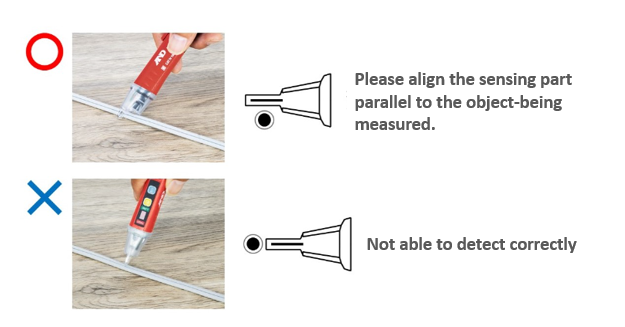AD-5571 How to use non-contact voltage tester correctly
A non-contact voltage tester is an electrical measuring instrument that helps to protect the lives of workers involved in electrical work.
However, using it incorrectly can pose a risk of electric shock and is very dangerous.
To prevent electric shock accidents, it is necessary to perform a functionality check before use.
Please use a known power source (such as an electrical outlet) or a voltage checker to verify proper operation.
When conducting actual voltage testing, bring the sensing part close to the object or electrical outlet being measured for AC voltage.
When the non-contact voltage tester detects an AC voltage signal, it will light up or play a sound to indicate the detection.
Align the sensing part so it is parallel to the object being measured, as shown in the diagram.

Proper way to align the sensing part
When conducting a non-contact voltage test on insulated wires, make sure to firmly place the sensing part directly on the wire to ensure optimal sensitivity and avoid the risk of non-detection.
Furthermore, if your hands or the voltage tester are wet, there is a risk of electric shock, so please refrain from using them.
You can easily adjust the sensitivity of the AD-5571, by using the buttons to switch between “High Voltage Induction Mode: 90-1000V” and “Low Voltage Response Mode: 24-1000V”.
It is recommended that you use “High Voltage Induction Mode” if you know that the voltage of the measured object exceeds 90V, as setting too high a sensitivity may cause the tester to react to other nearby live wires.
It is important to use a voltage tester that is suitable for the voltage and of AC/DC type, and to take precautions before use such as performing visual checks and checking the battery level.
Please read the instruction manual carefully before using the voltage tester.
